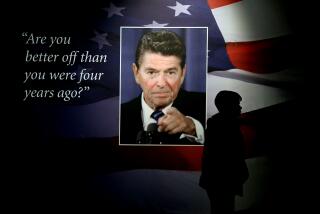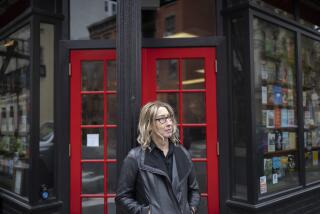Reagan Docents Train for Tours of Duty : Presidential library: Volunteers get ready to serve up information--including honest, tactful answers to visitors’ sometimes difficult questions.
- Share via
The question was how to explain the Iran-Contra scandal. The answer was clear to Peter Esau.
“We are not going to get into any controversies,” said Esau, a volunteer docent preparing for visitors’ questions at the Ronald Reagan presidential library and museum. “If someone wants to debate us, we will send them to a different place.”
Esau’s answer seemed to satisfy other docents who are preparing for the 250,000 visitors expected each year at the Reagan library on a hilltop above Simi Valley. The museum opens to the public on Nov. 5.
So far, 194 volunteers mount the hill three days a week to bone up on the personal histories of Ronald and Nancy Reagan and their eight years in the White House.
Library Director Ralph C. Bledsoe and his National Archives staff members have provided the volunteers with notebooks of background material. They suggest that docents answer questions honestly and to the best of their ability.
“The docents are not there to influence any people, but help guide people through the exhibits and let them draw their own conclusions,” Bledsoe said.
A majority of the docents-in-training come from Simi Valley and other nearby cities such as Thousand Oaks, Westlake Village and Camarillo. Many are well-educated retirees--former lawyers, engineers, administrators, teachers--with extra time on their hands.
Nearly all of them are longtime Reagan supporters and proud of it.
“Practically everyone I’ve talked to is a Reagan fan,” said John O’Leary, one of the volunteer organizers. “They just keep pouring in.”
In preparation for the library’s gala opening next month, each docent has adopted a section of the museum to gain quick expertise.
Eventually the docents, sporting matching red ties, white shirts and blue jackets or sweaters, will be trained to lead tours throughout the library.
But for now they are staking out their positions within the museum, getting ready to serve up bits of Reagan trivia.
Some have learned the origin of Nancy Reagan’s outfits on exhibit and details of her Foster Grandparents program. Others know the story behind the gifts on display from foreign leaders. A few of the ambitious ones decided to tackle Reagan’s domestic and foreign policies.
Those who volunteered for the foreign-policy gallery recently began debating how to handle the thorniest of possible subjects: the scandal over the attempt by Reagan aides to exchange arms for hostages and then divert profits from the arms sales to illegally finance the Nicaraguan Contras.
The gallery, designed at the direction of the Reagans and their staff, touches on the Iran-Contra scandal in one of the time-line exhibits marking significant foreign policy events during the Reagan Administration.
“It would be ridiculous to say it didn’t happen,” said Boris Palarz, a retired aerospace engineer from Simi Valley. “Men have been convicted.”
Palarz, the only self-declared Democrat in the discussion group, appealed to his colleagues for further study of the matter.
“We are not going to be the experts to resolve the issue,” said Robert Ley, another retired aerospace engineer and Simi Valley resident.
“There are reasons that it happened,” said Esau, a retired Simi Valley school administrator. With a confident voice and distinguished shock of white hair, Esau easily won converts to his approach: Be prepared with facts, offer no excuses and quickly move on to the next subject.
The museum, designed and assembled over three years with private donations, will be turned over to the National Archives with the rest of the 153,000-square-foot library during the dedication ceremony Nov. 4.
The museum will open to the public on the afternoon of Nov. 5, after Reagan’s former associates, friends and financial contributors have concluded a series of receptions and other events.
Workers continued to put the final touches on the museum last week, forcing museum Curator Ann Bethel to train the docents using a miniature model of the exhibit space.
“We are very fortunate to have such a highly educated group of talent,” Bethel said. “They are vital to the museum; they are the ones who will touch the public.”
For the most part, the docents are organizing themselves, she said. Collectively, they agreed on their own dress code of red, white, blue and gray.
Jerry Cassell, a former Air Force lieutenant colonel who retired to Simi Valley, has compiled the computerized list of 194 volunteers who have committed to 200 hours a year as docents.
The organizers are looking for volunteers with language skills to help lead special tour groups, Cassell said. So far, he said, the group includes volunteers who speak Spanish, German, Korean and Greek. In addition, one volunteer knows sign language to help the hearing-impaired.
Cassell said he cut off accepting more volunteers until after the library opens. “It’s that old Reagan magic. The response has been phenomenal.”
The Ronald Reagan Presidential Foundation, which built the $57-million library complex, has another, smaller group of volunteers who will help run cash registers in the library’s gift shop.
“I don’t ask if anybody is a registered Republican,” said Charles H. Jelloian, the foundation’s director of operations. “People let it be known of their enthusiasm for President Reagan, and we certainly like to hear that.”
Bledsoe has also assembled a smaller group to weed through extraneous publications of the Government Printing Office and to help him establish educational outreach programs for area schools.
The docents will not help a staff of professional archivists in the primary role of the library, reviewing and disseminating an estimated 55 million pages of original White House documents stored in the basement, Bledsoe said.
“We won’t have them monitoring the researchers or handling documents,” he said. “That’s the job of professional archivists.”
More to Read
Sign up for Essential California
The most important California stories and recommendations in your inbox every morning.
You may occasionally receive promotional content from the Los Angeles Times.










